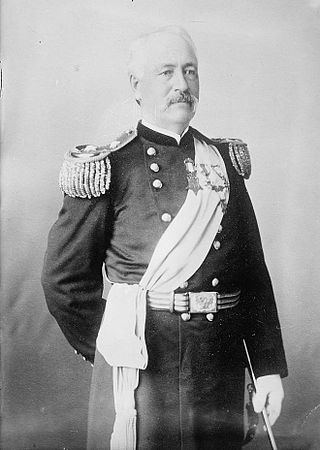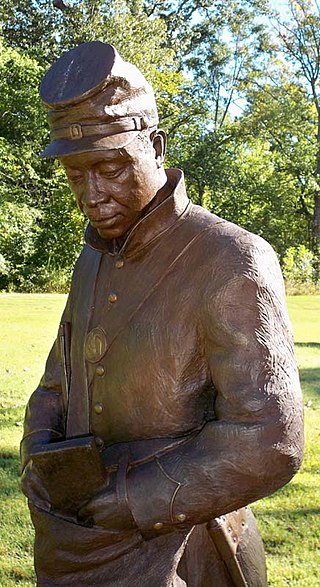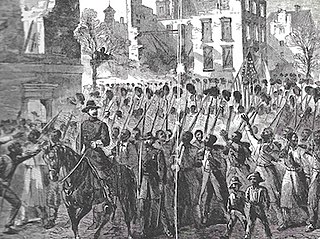
The African American Civil War Memorial Museum, in the U Street district of Washington, D.C., recognizes the contributions of the 209,145 members of the United States Colored Troops (USCT). The eponymous memorial, dedicated in July 1998 by the African American Civil War Memorial Freedom Foundation, commemorates the service of 209,145 African-American soldiers and about 7,000 white and 2,145 Hispanic soldiers, together with the approximate 20,000 unsegregated Navy sailors, who fought for the Union in the American Civil War, mostly among the 175 regiments of United States Colored Troops.
The 3rd Wisconsin Infantry Regiment was an infantry regiment that served in the Union Army during the American Civil War.
The 7th Wisconsin Infantry Regiment was an infantry regiment that served in the Union Army during the American Civil War. It was a component of the famous Iron Brigade in the Army of the Potomac throughout the war.
The 102nd United States Colored Infantry was an African American infantry regiment of United States Colored Troops in the Union Army during the American Civil War. The unit was organized as the 1st Michigan Colored Volunteer Infantry Regiment before being redesignated as the 102nd Regiment USCT.

John Baptiste Weber was a U.S. Representative from New York.

William Anderson Pile was a nineteenth-century politician and minister from Missouri, as well as a general in the Union Army during the American Civil War. He was Governor of New Mexico Territory from 1869 to 1871. His father's name was Jacob Pile and his mother's name was Comfort Williams.

Albert Duane Shaw was an American government official and politician from New York. A Union Army veteran of the American Civil War, he was most notable for his service as Commander-in-Chief of the Grand Army of the Republic and a U.S. Representative from New York's 24th congressional district.
The 1st Delaware Infantry Regiment, later known as the 1st Delaware Veteran Infantry Regiment was a United States volunteer infantry regiment raised for Union Army service in the American Civil War. Part of the II Corps it served in the Eastern Theater of the American Civil War.

The Excelsior Brigade was a military unit in the Union Army during the American Civil War. Mainly composed of infantry regiments raised in the state of New York primarily by former U.S. Representative Daniel Sickles, the brigade served in several of the Army of the Potomac's most important battles in the Eastern Theater, including Chancellorsville and Gettysburg.

Thomas Scott Allen was an American printer, teacher, newspaper publisher, and politician. He served as the 9th Secretary of State of Wisconsin and served as a Union Army officer throughout the American Civil War, earning an honorary brevet rank of brigadier general. Before the war he also served a term in the Wisconsin State Assembly, representing Iowa County, and later in life he was publisher of the Oshkosh Northwestern newspaper.

Henry Clay Merriam was a United States Army general. He received the United States military's highest decoration, the Medal of Honor, for his actions as a Union officer in command of African American troops during the American Civil War. He later served in various Indian Wars throughout the western United States and commanded the 7th Infantry Regiment. After being promoted to brigadier general, he took on a training and supply role during the Philippine–American War.

The 2nd Regiment Massachusetts Volunteer Infantry was an infantry regiment in the Union Army during the American Civil War. Major George H. Gordon, a West Point graduate and veteran of the Mexican–American War, organized the unit's recruitment and formation. The 2nd Massachusetts was trained at Camp Andrew in West Roxbury, Massachusetts on the site of the former Transcendentalist utopian community, Brook Farm. Roughly half the regiment was mustered in on May 18, 1861 and the remainder on May 25, 1861 for a term of three years. The regiment saw extensive combat as part of the Army of the Potomac particularly during the Battle of Antietam and the Battle of Gettysburg.

The 55th United States Colored Infantry Regiment was a United States Colored Troops infantry regiment in the Union Army during the American Civil War. It was first organized as the 1st Alabama Volunteer Infantry Regiment (African Descent) in May 1863, serving on garrison duty at Corinth, Mississippi and Memphis, Tennessee. It was redesignated as the 55th United States Colored Infantry in March 1864, continuing its garrison service in Tennessee and fighting at the Battle of Brices Cross Roads. After the end of the war, the regiment was mustered out in late 1865 after garrison duty in Louisiana.
The 26th United States Colored Infantry, also called the 26th New York Infantry (Colored) was an African American infantry regiment, one of three colored troop units from the state of New York,1 that fought in the American Civil War. The unit was organized on Riker's Island in February 1864 by the Union League Club of New York.

The 130th Pennsylvania Volunteer Infantry was an infantry regiment that served in the Union Army during the American Civil War.

The 55th Massachusetts Infantry Regiment was the sister regiment of the renowned Massachusetts 54th Volunteers during the latter half of the American Civil War. The enactment of the Emancipation Proclamation by United States President Abraham Lincoln on January 1, 1863 opened the way for the enlistment of free men of color and newly liberated slaves to fight for their freedom within the Union Army. As the ranks of the 54th Massachusetts quickly reached its full complement of recruits, an overflow of colored volunteers continued to pour in from several other states outside Massachusetts — many of whom simply had not arrived in time — prompting Governor John Albion Andrew to authorize yet another regiment of colored soldiers sponsored by the Commonwealth. Lieutenant Colonel Norwood P. Hallowell of the 54th Massachusetts was promoted to colonel and appointed commander of the 55th Massachusetts on May 30, 1863. Five companies of the 55th Massachusetts were mustered into service on May 31; two more companies were mustered in on June 15; and the last three on June 22.
The 14th United States Colored Infantry Regiment was an infantry regiment that served in the Union Army during the American Civil War. The regiment was composed of African American enlisted men commanded by white officers and was authorized by the Bureau of Colored Troops which was created by the United States War Department on May 22, 1863.

William Gould (W.G.) Raymond (1819–1893), a pastor, chaplain and American soldier in the Union Army during the American Civil War, played a prominent role in the initial recruitment of the first federal African American regiments of the Union Army. In the period between the Emancipation Proclamation and the establishment of the Bureau of Colored Troops in 1863, Raymond, along with J.D. Turner, received authorization from President Abraham Lincoln to recruit and command the first federal African-American Union Army troops from the District of Columbia. Prior to this, African-American troops were raised at the state level only, without the direct authorization of Lincoln. The troops recruited by Raymond and Turner would become the 1st United States Colored Infantry Regiment and the first regiment of the United States Colored Troops (U.S.C.T), enduring threats and significant obstacles, but ultimately serving with distinction.

The 20th United States Colored Infantry was an infantry regiment that served in the Union Army during the American Civil War. The regiment was composed of African American enlisted men commanded by white officers and was authorized by the Bureau of Colored Troops which was created by the United States War Department on May 22, 1863.

Thomas Sloan Bell Jr. was an American soldier who served as a Union Army lieutenant colonel of the 51st Pennsylvania Infantry Regiment during the American Civil War. He was killed in action at the Battle of Antietam shortly after capturing a key stone bridge over Antietam Creek held by Confederate troops.














